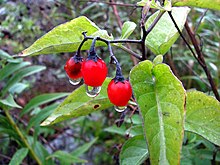| Bittersweet nightshade | |
|---|---|

| |
| Solanum dulcamara[1] | |
| Scientific classification | |
| Kingdom: | Plantae |
| Clade: | Tracheophytes |
| Clade: | Angiosperms |
| Clade: | Eudicots |
| Clade: | Asterids |
| Order: | Solanales |
| Family: | Solanaceae |
| Genus: | Solanum |
| Species: | S. dulcamara
|
| Binomial name | |
| Solanum dulcamara | |
Solanum dulcamara is a species of vine in the genus Solanum (which also includes the potato and the tomato) of the family Solanaceae. Common names include bittersweet, bittersweet nightshade, bitter nightshade, blue bindweed, Amara Dulcis,[3] climbing nightshade,[4] felonwort, fellenwort, felonwood, poisonberry, poisonflower, scarlet berry, snakeberry,[5][6][7] trailing bittersweet, trailing nightshade, violet bloom, and woody nightshade.
It is native to Europe and Asia, and widely naturalised elsewhere, including North America.
- ^ illustration by Kurt Stüber, published in Prof. Dr. Otto Wilhelm Thomé Flora von Deutschland, Österreich und der Schweiz 1885, Gera, Germany
- ^ Sp. Pl. 1: 185. 1753 [1 May 1753] "Plant Name Details for Solanum dulcamura". IPNI. Retrieved December 1, 2009.
- ^ Culpeper Plant Names Database, discussing various editions of Culpeper, for example Culpeper, Nicholas, The English physitian: or an astrologo-physical discourse of the vulgar herbs of this nation, London, Peter Cole, 1652.
- ^ USDA, NRCS (n.d.). "Solanum dulcamara". The PLANTS Database (plants.usda.gov). Greensboro, North Carolina: National Plant Data Team. Retrieved 17 November 2015.
- ^ Blanchan, Neltje (2005). Wild Flowers Worth Knowing. Project Gutenberg Literary Archive Foundation.
- ^ "Almost any unfamiliar berry is or may be snake-berry, and all snake-berries are poisonous; so a boy dares not eat a berry till some one...". Needs verification but may come from Fannie D. Bergen (November 1892). "Popular American Plant Names". Botanical Gazette. 17 (11): 363–380. doi:10.1086/326860. S2CID 224830265.
- ^ "Guide to Poisonous and Toxic Plants (Technical Guide #196)". US Army center for health promotion and preventive medicine, Entomological Sciences Program. July 1994. Archived from the original on May 4, 2008.